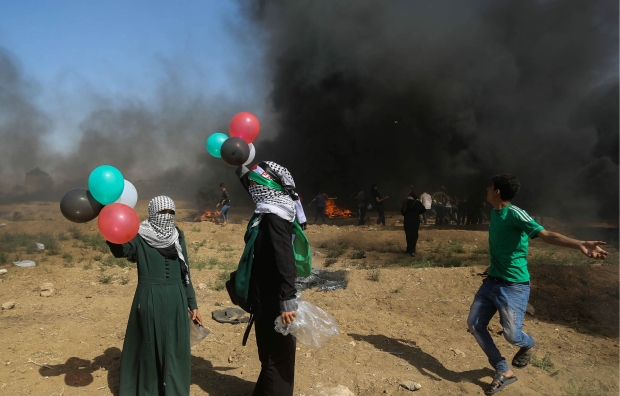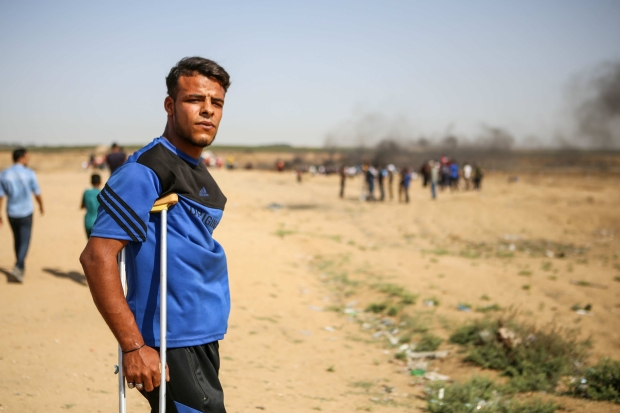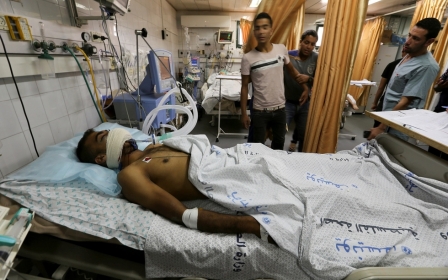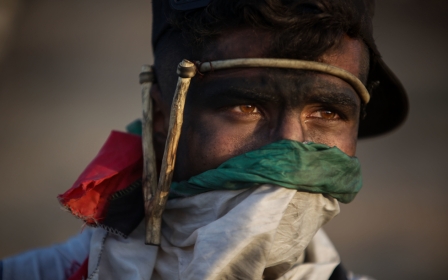Gaza protesters mark 'Friday of the Wounded'

Palestinians once again showed up to demonstrations in the Gaza Strip for what had been officially designated as “Friday of the Wounded”, marking 85 days since the beginning of the Great March of Return.
The Gaza health ministry reported that 206 demonstrators, including at least eight minors, had been injured as of 8pm local time on Friday. Crowds only began forming in the late afternoon, with one Middle East Eye correspondent estimating that at least 7,000 people were attending protests all along the fence separating Gaza from Israel.
MEE's reporter said Israeli forces fired large quantities of tear gas and live bullets east of Gaza City, where demonstrators were burning tyres to obstruct the view of Israeli snipers, as well as holding balloons with the names and faces of Palestinians killed during the nearly three months of protests.
While the marches have denounced the abysmal living conditions in Gaza, 11 years into a stringent Israel-imposed and Egypt-supported blockade, they have more broadly focused on calling for the right of return of Palestinian refugees - which make up 1.3 million of Gaza’s two million inhabitants - whose families were forcibly expelled from their homes during the creation of the state of Israel in 1948.
“This is the Friday of the wounded, the Friday of loyalty, the Friday of return, the Friday of steadfastness, the Friday of confrontation and resistance,” Mohammed, one of the many demonstrators who attended the protest on crutches, told Middle East Eye.
“We will persevere until we obtain our rights to our land - the land of life, of freedom and of return.”
At least 133 Palestinians have been killed and 14,600 wounded by Israeli forces since the protests began on 30 March, according to the Gaza health ministry.
Of those wounded, at least 3,900 have been injured by live bullets and another 500 by rubber-coated steel bullets, while more than 6,500 suffered from excessive tear gas inhalation, according to ministry data dating from 12 June.
Health organisations and Gaza’s health ministry have repeatedly warned about the difficult conditions in the besieged enclave’s hospitals because of poor access to electricity and material shortages. The Israeli army’s violent repression of the Great March of Return has only further strained health resources in Gaza.
NGOs such as Physicians for Human Rights - Israel (PHRI) have also slammed the Israeli government for denying numerous Palestinians’ requests for exit permits in order to receive adequate treatment in the occupied West Bank for their wounds. Israel’s denial of exit permits has been blamed for at least 43 Palestinians having limbs amputated because of lack of access to proper care.
Like at least 5,000 others, 24-year-old Mustafa was injured in the leg while demonstrating, marking the third time he has been shot by Israeli forces since 2015.
“Every injury is worse than the previous one,” said Mustafa, adding that his most recent injury occurred while he was tying Palestinian flags to barbed wire installed by Israeli forces inside Gaza. “My knee is gone beyond repair, my arteries have been severed... But even until my last breath, if I have a chance to defend my land and dignity, I will do it."
The sentiment was echoed by fellow protester Mahmoud.
"As an injured person, I come to let the Israelis know that we aren’t giving up on our land. I come every Friday, and even if they shot me in both legs, I would keep coming," he told MEE.
"They throw death at us, but we cultivate life."
Reporting on the ground in Gaza by Mohammed al-Hajjar and Mohammed al-Asad.
New MEE newsletter: Jerusalem Dispatch
Sign up to get the latest insights and analysis on Israel-Palestine, alongside Turkey Unpacked and other MEE newsletters
Middle East Eye delivers independent and unrivalled coverage and analysis of the Middle East, North Africa and beyond. To learn more about republishing this content and the associated fees, please fill out this form. More about MEE can be found here.






